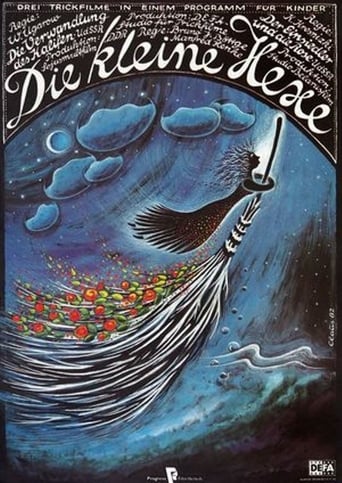DEFA-Studio für Trickfilme
Das hässliche junge Entlein 1982
Animated short film based on Andersen's tale.
Einmart 1981
The very first images in the film set unprecedented standards in East German animated film: a Buñuelean eye that fills the entire screen, real-life sequences of fleeing animals and a sound collage running contrary to what is seen on the screen. This also extends to the protagonist of the film, a head on a foot without a body or arms who pads wearily through the depressing surroundings. Upon seeing various figures in the sky, he begins to copy their movements. To his surprise, he himself manages to grow wings and takes to the skies. But his attempt at flight ends in a sobering manner however, as it is revealed that flying creatures are just restricted in their range.
The Flying Windmill 1982
Olli, the main character in the movie, got a very bad grade and is terribly annoyed. She runs away from home and, together with a dog and a horse, finds a (mad? nutty?) scientist in a windmill. They experience the strangest adventures in this windmill and find other interesting characters, a lot of excitement and peril. While you may well interpret something as the "socialist value system" into this movie, it is more meant to be a children's movie, showing the kids that there are more exciting things out there than the ones that your parents and teachers show you, and that you will only find out most of those things on your own, if you show enough curiosity.
Jorinde und Joringel 1958
The Farmer's Clever Daughter 1984
Puppet animated film based on a fairytale by the Brothers Grimm.
Metamorphoses I 1978
For the multimedia exhibition Tangenten I (Tangents I), Dammbeck and co-organizer, sculptor and painter Frieder Heinze had planned to collaborate on a film that would combine non-camera animation with 35mm footage of a train ride between the two Dresden districts of Radebeul and Pieschen. When the exhibition was banned in 1978, Heinze turned to other projects, but Dammbeck continued working on the film by himself. Metamorphoses I—the first experimental film ever to be shown publicly in East Germany—marks the filmic beginning of Dammbeck’s long-term art project the Herakles-Konzept (Hercules Concept).
Variants 1980
Two neighbours argue about which one of them should get rid of a pile of rubbish.
Die große Reise der alten Schildkröte 1989
Somewhere in an unknown land of turtles, an old turtle wants to see the world. After hearing a cancan record she wants to dance and decides to take a ship to Europe - to Paris. Once there, she learns how to do the cancan, wears sequinned dresses, stiletto-heeled shoes and net stockings. She loses these wonderful things on her journey home but she still has her memories and the zest for life.
A Young Man Named Engels – A Portrait in Letters 1970
With the young Friedrich Engel’s letters and drawings from the years between 1838 and 1842, a unique cinematic portrait is created. The viewer thus gets to know the young Engels personally, learning about the significant moments of his development from a bourgeois-liberal upbringing to the theoretical partner of Karl Marx. Later be awarded the Gold Dove at the International Leipzig Documentary and Short Film Week.
The Little Witch 1983
The little witch is not interested in the basics of magic. She does not want to study at all! But everything changes when she meets the handsome Prince and falls in love with him. She helps the Prince with her magical powers, protecting him from dangerous obstacles and marriage to a woman he does not love.
Der rechte Barbier 1960
The Red Maple Leaf 1976
Dwarf Nose 1986
For his mockery a witch transforms the pert boy Jacob into an ugly dwarf, but teaches him at the same time how to cook. Jacob quickly becomes a master of his trade and is named the prince's first cook. Only the mysterious herb "sneeze-with-passion" is unknown to him. Based on a fairy tale by Wilhelm Hauff.
Sirens 1984
The song of the sirens, sitting on the rocks, attracts to her kingdom sailors from beyond: Greeks, Vikings, Pirates ...

















